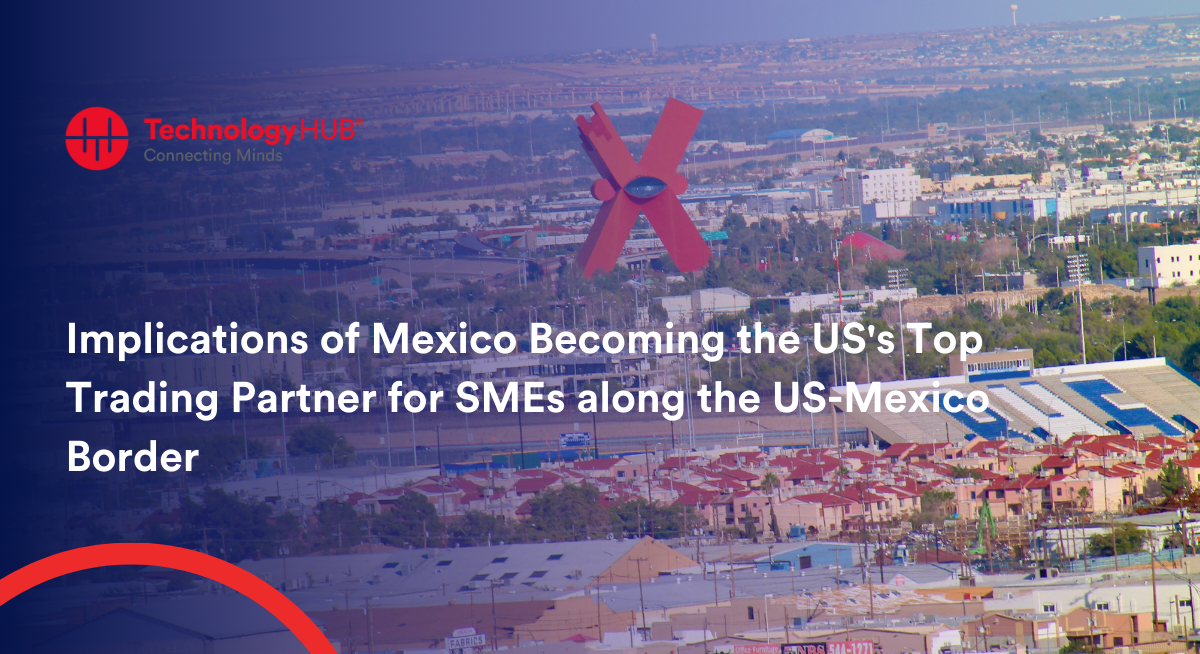Mexico's ascent to becoming the United States' largest trading partner has far-reaching implications, especially for small and medium-sized enterprises (SMEs) operating along the US-Mexico border.
This shift, largely driven by geopolitical changes and nearshoring trends, offers both opportunities and challenges for these businesses.
The Rise of Mexico as a Top Trading Partner
In early 2023, Mexico surpassed China and Canada to become the US's top trading partner, with bilateral trade reaching $263 billion in the first four months alone. This significant milestone underscores the deepening economic ties between the two nations, particularly in the manufacturing sector. Trade in manufactured goods reached $234.2 billion, highlighting Mexico's critical role in the supply chain of various industries, including automotive, electronics, and textiles.
Nearshoring: A Catalyst for Growth
Nearshoring, the practice of relocating business operations closer to home, has gained momentum as companies seek to reduce supply chain risks and costs. This trend has been particularly beneficial for Mexico, with predictions that manufacturing exports to the US could soar to $600 billion by 2028. SMEs stand to gain significantly from this shift as they integrate into new supply chains and expand their market reach.
Opportunities for SMEs
1. Increased Trade Volume: The increase in trade activities presents SMEs with more opportunities to engage in cross-border commerce. Enhanced trade relations mean that SMEs can expect a more stable and predictable market environment, conducive to long-term planning and investment.
2. Integration into Supply Chains: Nearshoring opens doors for SMEs to become key players in the supply chains of larger multinational companies. This integration can lead to increased demand for locally produced goods and services, fostering growth and innovation.
3. Technological Advancements: The emphasis on digital trade within the USMCA (United States-Mexico-Canada Agreement) provides SMEs with a framework to modernize their operations. Adopting digital tools for transactions, logistics, and communication can streamline operations and enhance efficiency.
How SMEs Can Prepare
1. Enhancing Logistical Capabilities: With the expected increase in trade volume, SMEs must invest in efficient transportation and customs processes. Advanced logistics software can help manage supply chain complexities and improve operational efficiency.
2. Embracing Digital Trade: Leveraging digital trade solutions such as e-commerce platforms and digital payment systems will enable SMEs to expand their market reach and simplify cross-border transactions. Understanding and utilizing the digital trade provisions in the USMCA can provide a competitive edge.
3. Building Strategic Partnerships: Collaborating with larger firms and local governments can provide SMEs with the necessary support to navigate international trade complexities. Partnerships can offer access to funding, infrastructure, and valuable market insights.
4. Adapting to Regulatory Changes: Staying informed about regulatory changes and trade policies under the USMCA is crucial. SMEs need to ensure compliance with new trade agreements and leverage favorable terms for cross-border transactions.
Challenges and Considerations
1. Infrastructure and Security: Despite the growth potential, challenges such as inadequate infrastructure and security concerns remain significant. SMEs must advocate for improvements in transport logistics, power reliability, and port security to ensure smooth operations.
2. Financial Preparedness: Economic fluctuations and interest rate changes in both Mexico and the US can impact SME operations. Building financial resilience through diversified funding sources and hedging against currency risks is essential.
3. Workforce Development: Investing in workforce training and development will be crucial for SMEs to meet the demands of increased production and technological advancements. Programs aimed at enhancing employee skills can ensure competitiveness in the evolving market.
Conclusion
Mexico's position as the US's top trading partner brings a myriad of opportunities and challenges for SMEs along the US-Mexico border. By strategically preparing and adapting to these changes, SMEs can leverage this shift to drive growth, enhance resilience, and capitalize on new market dynamics. The nearshoring trend, coupled with strong bilateral trade relations, positions SMEs to play a vital role in the economic landscape of North America.
Discover how the Technology Hub Business Center can help both large and small companies relocate and thrive in Mexico. Our modern, technology-based center is just 5 minutes from the southern US-Mexico border, providing a strategic location for businesses looking to capitalize on nearshoring opportunities. Visit our website to learn more about how we can support your company's growth and integration into the Mexican market.

